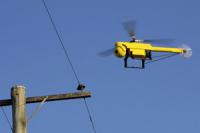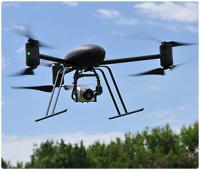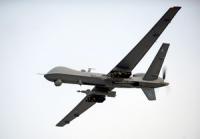-
Fleets of drones could aid searches for lost hikers
Finding lost hikers in forests can be a difficult and lengthy process, as helicopters and drones can’t get a glimpse through the thick tree canopy. Recently, it’s been proposed that autonomous drones, which can bob and weave through trees, could aid these searches. But the GPS signals used to guide the aircraft can be unreliable or nonexistent in forest environments. New system allows drones to cooperatively explore terrain under thick forest canopies where GPS signals are unreliable.
-
-
Drones could be used to detect dangerous “butterfly” landmines
It is estimated that there are at least 100 million military munitions and explosives of concern devices in the world, of various size, shape and composition. Millions of these are surface plastic landmines with low-pressure triggers, such as the mass-produced Soviet PFM-1 “butterfly” landmine. Drones could be used to detect dangerous “butterfly” landmines in remote regions of post-conflict countries.
-
-
Los Alamos lab designated “No Drone Zone,” deploys counter-drone systems
Loa Alamos National Laboratory, in collaboration with the National Nuclear Security Administration (NNSA) and the Federal Aviation Administration (FAA), has deployed a system to counter all unauthorized unmanned aircraft systems (UAS) over its restricted airspace and an additional FAA designated “No Drone Zone.” The Counter-UAS program at Los Alamos will be the blueprint for future programs at three other NNSA sites. Systems are planned for the Pantex Plant in Texas, the Y-12 facility in Tennessee, and the National Nuclear Security Site in Nevada.
-
-
Recommended: An action plan on U.S. drone policy
Drones have become a mainstay of U.S. counterterrorism operations and national security policy writ large. The Obama administration popularized the use of armed drones, and U.S. drone policy have only become more salient during the Trump administration – but the Trump administration’s approach to U.S. drone policy has thus far revealed a desire to roll back some of the principles, procedures, and guidelines put in place by the Obama administration.
-
-
Does the government really need this much power to deal with an attack of the drones?
Last week, the Senate Homeland Security and Governmental Affairs Committee held a hearing on the Preventing Emerging Threats Act of 2018 (S. 2836), which would give DOJ and DHS sweeping new authority to counter malicious drones. Among other things, the bill would authorize DOJ and DHS to “track,” “disrupt,” “control,” “seize or otherwise confiscate,” or even “destroy” unmanned aircraft that pose a “threat” to certain facilities or areas in the U.S. Given the breadth of these proposed new powers, you would expect officials to have a strong case for passing the bill. But even after the hearing, it’s not clear why DHS and DOJ need any expanded authority to go after “malicious” drones.
-
-
NIST boosts drone forensics with new data on its website
Aerial drones might someday deliver online purchases to your home. But in some prisons, drone delivery is already a thing. Drones have been spotted flying drugs, cell phones and other contraband over prison walls, and in several cases, drug traffickers have used drones to ferry narcotics across the border. If those drones are captured, investigators will try to extract data from them that might point to a suspect.
-
-
Testing and demonstrating drones -- and showing what they can do
“Drones” have proven useful both for the military and the public. They can be relatively inexpensive gadgets with a variety of capabilities such as taking aerial photos and video, surveilling, and carrying objects. However, until now, DHS could not evaluate and demonstrate drones in a timely manner because of the lack of a common testing site and high costs. DHS S&T is preparing to integrate drones in DHS’ and other federal agencies’ missions by providing accessible demonstration sites for land- and maritime-based operations.
-
-
Truly autonomous systems to learn “on the fly”
Almost all artificial intelligence, or AI, technology is reliant on the availability of massive amounts of data, but engineers are now trying to develop machines that can learn “on the fly” in situations where there is little data to inform them. The engineers hope their efforts will assist the Department of Defense in the development of truly autonomous systems that can not only operate in challenging environments but also survive disruptions or recognize when they are fatal.
-
-
How are drones changing warfare, threatening security?
The Trump administration recently announced a new policy that could vastly expand the sale of armed aerial drones, a specialty of Professor Nicholas Grossman, the author of the new book Drones and Terrorism: Asymmetric Warfare and the Threat to Global Security. “Most people focus on governments deploying drones, but terrorists, insurgents and other nonstate actors are using them as well,” he said. “The growing commercial drone market also creates concerns that terrorists will deploy them in the United States and other developed countries.”
-
-
Securing U.S. skies
Extended stretches of U.S. land borders invite illegal entry on the ground, and U.S. coastlines are often used for unauthorized seaborne entry. New, creative attempts at illegal activity in these domains are a daily occurrence. Aerial threats pose a different challenge as they have no natural barriers restricting them — land or coastal. Commercialization of drone technology, for all the beneficial opportunities it provides, also enables a new medium for criminal activity and other homeland security threats.
-
-
Drones learn to navigate autonomously by imitating cars, bicycles

Researchers have developed an algorithm called DroNet which allows drones to fly completely by themselves through the streets of a city and in indoor environments. The algorithm had to learn traffic rules and adapt training examples from cyclists and car drivers.
-
-
Detect illicit drone video filming

Researchers have demonstrated the first technique to detect a drone camera illicitly capturing video. Their study addresses increasing concerns about the proliferation of drone use for personal and business applications and how it is impinging on privacy and safety.
-
-
FAA declares seven nuclear research facilities no-drone zones
The Federal Aviation Administration (FAA) has granted a request from the Department of Energy (DOE) to declare seven DOE’s nuclear research facilities no-drone zones. Starting 29 December, drone operators would not be allowed to fly their UAVs within 400 feet of these facilities: The FAA said it is currently considering more “no-drone zone” requests from federal agencies.
-
-
Mimicking peregrine falcon attack strategies could help down rogue drones
Researchers have discovered that peregrine falcons steer their attacks using the same control strategies as guided missiles. The findings, which overturn previous assumptions that peregrines’ aerial hunting follows simple geometric rules, could be applied to the design of small, visually guided drones that can take down other ‘rogue’ drones in settings such as airports or prisons.
-
-
Counter UAVs to drive enemy drones out of the sky

Defense drones to seek out and bring down hostile military UAVs are being developed in Australia. Military drones have changed the landscape of the modern battlefield in recent years, but the technology to counter them has not kept pace. Reacting to this gap in the market the startup is developing two models in Adelaide, South Australia. The first is a compact counter UAV drone with metal rotors that can be stored in a soldier’s pack and launched when an enemy drone is believed to be in the area.
-
- All
- Regional
- Water
- Biometrics
- Borders/Immig
- Business
- Cybersecurity
- Detection
- Disasters
- Government
- Infrastructure
- International
- Public health
- Public Safety
- Communication interoperabillity
- Emergency services
- Emergency medical services
- Fire
- First response
- IEDs
- Law Enforcement
- Law Enforcement Technology
- Military technology
- Nonlethal weapons
- Nuclear weapons
- Personal protection equipment
- Police
- Notification /alert systems
- Situational awareness
- Weapons systems
- Sci-Tech
- Sector Reports
- Surveillance
- Transportation
Advertising & Marketing: advertise@newswirepubs.com
Editorial: editor@newswirepubs.com
General: info@newswirepubs.com
2010-2011 © News Wire Publications, LLC News Wire Publications, LLC
220 Old Country Road | Suite 200 | Mineola | New York | 11501
Permissions and Policies
Editorial: editor@newswirepubs.com
General: info@newswirepubs.com
2010-2011 © News Wire Publications, LLC News Wire Publications, LLC
220 Old Country Road | Suite 200 | Mineola | New York | 11501
Permissions and Policies
